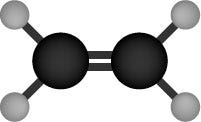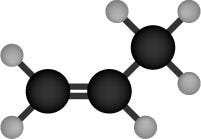Olefins
Olefins, also known as alkenes, are unsaturated hydrocarbons with a double bond between two carbons in the molecule. Olefins are produced by using thermal hydrocarbon cracking at high heat to refine gaseous or liquid hydrocarbon feedstocks, such as naphtha and natural gas condensates like ethane and propane, into smaller hydrocarbon chains. These hydrocarbon components, olefins, can be sold as-is or recombined into new configurations to form many high-value chemical compounds, including polyethylene and synthetic rubber.
Ethylene (ethene)


Ethylene, or ethene under IUPAC nomenclature, is the simplest of the alkenes, with chemical formula C2H4. It is a colorless flammable gas. Ethylene is the largest volume petrochemical produced globally and can be used in myriad ways throughout the chemical industry. For example, ethylene molecules can be combined via polymerization to form the plastic polyethylene, which is commonly used in plastic films such as trash bags and air pillow packaging as well as bottles, appliances, toys, and more. Ethylene can also be used in the agriculture industry as a natural plant hormone to promote crop growth.
Propylene (propene)


Propylene or propene, C2H6, is a highly flammable gas formed by cracking propane and other light hydrocarbons. Propylene can be converted via oxidation to propylene oxide, the primary component used to make glycol ethers and ethylene glycol, from which we derive polyesters and engine coolant. Propylene is also used to make isopropyl alcohol, acrylic acids, and other important chemicals. Polymerization of propene yields polypropylene, the second-highest produced commercial-use plastic after polyethylene; polypropylene can be formed either into fibers or plastics and is used in bottles, packaging supplies, upholstery, home furnishings, ropes, and many other products used in our daily lives.
Butylene (butene)


Butylene, C4H8, is a byproduct of the refining of crude oil, extracted via catalytic cracking. It is a colorless, flammable gas and has a distinct petroleum odor. Butylene can form in any of four different isomeric configurations. Any of these can act as monomers in the formation of polymers. Butylene can be used as feedstock for MTBE, which improves the combustion of gasoline, or for isoprene, the main component of many rubbers. However, one of its most valuable uses is as a petrochemical intermediate in producing the diene 1,3-butadiene, commonly known simply as butadiene.
Butadiene


Butadiene, chemical compound (CH2=CH)2, is a byproduct of the steam cracking process used to produce other olefins. It can also be formed from the catalytic dehydrogenation of n-butane or butene. Butadiene is the primary component of most synthetic rubbers. For example, polymerization with the copolymer styrene yields styrene-butadiene (SBR), from which automobile tires are made. Nitrile rubber, also known as NBR or Buna-N, is a copolymer of butadiene and acrylonitrile; this rubber is used in the automotive, aeronautical, medical, nuclear, and other industries due to its high level of resistance to chemicals such as oil, fuel, acids as well as its puncture-resistant nature.
